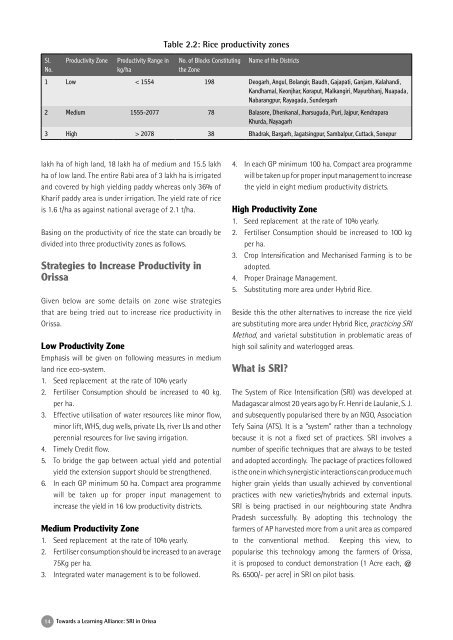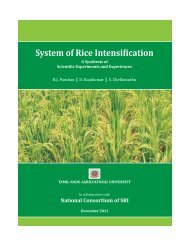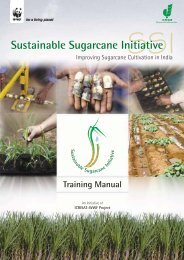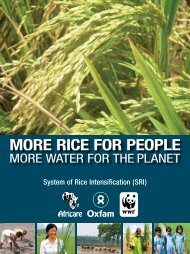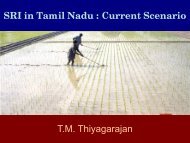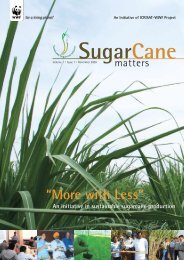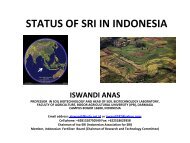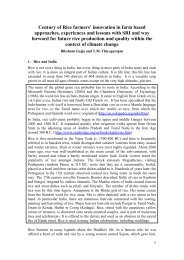SRI in Orissa - Cornell International Institute for Food, Agriculture ...
SRI in Orissa - Cornell International Institute for Food, Agriculture ...
SRI in Orissa - Cornell International Institute for Food, Agriculture ...
You also want an ePaper? Increase the reach of your titles
YUMPU automatically turns print PDFs into web optimized ePapers that Google loves.
Sl.<br />
No.<br />
Productivity Zone<br />
Productivity Range <strong>in</strong><br />
kg/ha<br />
Table 2.2: Rice productivity zones<br />
No. of Blocks Constitut<strong>in</strong>g<br />
the Zone<br />
Name of the Districts<br />
1 Low < 1554 198 Deogarh, Angul, Bolangir, Baudh, Gajapati, Ganjam, Kalahandi,<br />
Kandhamal, Keonjhar, Koraput, Malkangiri, Mayurbhanj, Nuapada,<br />
Nabarangpur, Rayagada, Sundergarh<br />
2 Medium 1555-2077 78 Balasore, Dhenkanal, Jharsuguda, Puri, Jajpur, Kendrapara<br />
Khurda, Nayagarh<br />
3 High > 2078 38 Bhadrak, Bargarh, Jagats<strong>in</strong>gpur, Sambalpur, Cuttack, Sonepur<br />
lakh ha of high land, 18 lakh ha of medium and 15.5 lakh<br />
ha of low land. The entire Rabi area of 3 lakh ha is irrigated<br />
and covered by high yield<strong>in</strong>g paddy whereas only 36% of<br />
Kharif paddy area is under irrigation. The yield rate of rice<br />
is 1.6 t/ha as aga<strong>in</strong>st national average of 2.1 t/ha.<br />
Bas<strong>in</strong>g on the productivity of rice the state can broadly be<br />
divided <strong>in</strong>to three productivity zones as follows.<br />
Strategies to Increase Productivity <strong>in</strong><br />
<strong>Orissa</strong><br />
Given below are some details on zone wise strategies<br />
that are be<strong>in</strong>g tried out to <strong>in</strong>crease rice productivity <strong>in</strong><br />
<strong>Orissa</strong>.<br />
Low Productivity Zone<br />
Emphasis will be given on follow<strong>in</strong>g measures <strong>in</strong> medium<br />
land rice eco-system.<br />
1. Seed replacement at the rate of 10% yearly<br />
2. Fertiliser Consumption should be <strong>in</strong>creased to 40 kg.<br />
per ha.<br />
3. Effective utilisation of water resources like m<strong>in</strong>or flow,<br />
m<strong>in</strong>or lift, WHS, dug wells, private LIs, river LIs and other<br />
perennial resources <strong>for</strong> live sav<strong>in</strong>g irrigation.<br />
4. Timely Credit flow.<br />
5. To bridge the gap between actual yield and potential<br />
yield the extension support should be strengthened.<br />
6. In each GP m<strong>in</strong>imum 50 ha. Compact area programme<br />
will be taken up <strong>for</strong> proper <strong>in</strong>put management to<br />
<strong>in</strong>crease the yield <strong>in</strong> 16 low productivity districts.<br />
Medium Productivity Zone<br />
1. Seed replacement at the rate of 10% yearly.<br />
2. Fertiliser consumption should be <strong>in</strong>creased to an average<br />
75Kg per ha.<br />
3. Integrated water management is to be followed.<br />
4. In each GP m<strong>in</strong>imum 100 ha. Compact area programme<br />
will be taken up <strong>for</strong> proper <strong>in</strong>put management to <strong>in</strong>crease<br />
the yield <strong>in</strong> eight medium productivity districts.<br />
High Productivity Zone<br />
1. Seed replacement at the rate of 10% yearly.<br />
2. Fertiliser Consumption should be <strong>in</strong>creased to 100 kg<br />
per ha.<br />
3. Crop Intensification and Mechanised Farm<strong>in</strong>g is to be<br />
adopted.<br />
4. Proper Dra<strong>in</strong>age Management.<br />
5. Substitut<strong>in</strong>g more area under Hybrid Rice.<br />
Beside this the other alternatives to <strong>in</strong>crease the rice yield<br />
are substitut<strong>in</strong>g more area under Hybrid Rice, practic<strong>in</strong>g <strong>SRI</strong><br />
Method, and varietal substitution <strong>in</strong> problematic areas of<br />
high soil sal<strong>in</strong>ity and waterlogged areas.<br />
What is <strong>SRI</strong>?<br />
The System of Rice Intensification (<strong>SRI</strong>) was developed at<br />
Madagascar almost 20 years ago by Fr. Henri de Laulanie, S. J.<br />
and subsequently popularised there by an NGO, Association<br />
Tefy Sa<strong>in</strong>a (ATS). It is a “system” rather than a technology<br />
because it is not a fixed set of practices. <strong>SRI</strong> <strong>in</strong>volves a<br />
number of specific techniques that are always to be tested<br />
and adopted accord<strong>in</strong>gly. The package of practices followed<br />
is the one <strong>in</strong> which synergistic <strong>in</strong>teractions can produce much<br />
higher gra<strong>in</strong> yields than usually achieved by conventional<br />
practices with new varieties/hybrids and external <strong>in</strong>puts.<br />
<strong>SRI</strong> is be<strong>in</strong>g practised <strong>in</strong> our neighbour<strong>in</strong>g state Andhra<br />
Pradesh successfully. By adopt<strong>in</strong>g this technology the<br />
farmers of AP harvested more from a unit area as compared<br />
to the conventional method. Keep<strong>in</strong>g this view, to<br />
popularise this technology among the farmers of <strong>Orissa</strong>,<br />
it is proposed to conduct demonstration (1 Acre each, @<br />
Rs. 6500/- per acre) <strong>in</strong> <strong>SRI</strong> on pilot basis.<br />
14<br />
Towards a Learn<strong>in</strong>g Alliance: <strong>SRI</strong> <strong>in</strong> <strong>Orissa</strong>


